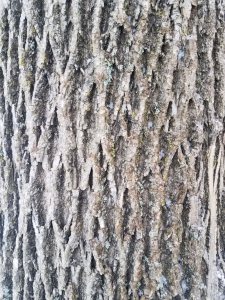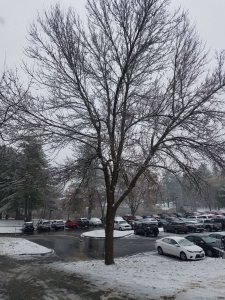Green Ash
Fraxinus pennsylvanica | Family: Oleaceae
Submission: Lars Gundersen ’20 and Ronni Mak ’20
Leaves – Similar to Fraxinus americana, but leaflets often narrower and always with some serration; opposite, deciduous, pinnately compound with 7-9 3-4” leaflets; ovate with smooth margin; more or less petioled.
Twigs and Bud – Similar to Fraxinus americana, but more or less pubescent, with leaf scar shallowly notched to truncate; first pair of lateral buds about at the same level as terminal bud; slender, grey to greenish brown twigs, with a pointed bud at the tip.
Fruit and Cone – Similar to Fraxinus americana, but generally narrower; dioecious spring flowers; fruit 1-2” narrow samara which matures in the fall; wing often pointed at apex, and enclosing ½ of seed cavity.
Bark – Scaly on young trees; becoming similar to Fraxinus americana; ashy-gray; divided into shallow furrows shaped into diamond patterns.
Natural History:
Important as an urban shade tree, renowned for its excellent bending qualities for use in tools and baseball bats, and famed for its adaptability and drought tolerance, green ash is an important tree found throughout the eastern and central United States. A member of the Oleaceae (olive) family, green ash is intolerant to moderately tolerant of shade competition and very tolerant of drought, due to its substantial root system. Trees can grow up to 40 feet (12 meters) tall and can have root systems which grow out more than 50 feet (15 meters) and down 3-4 feet (91-122 cm). Green ash trees typically live for 100-120 years. The species is most common in bottomlands in the Mississippi basin, but can survive dry, windswept sites as far southwest as Texas and Oklahoma, cold sites from Alberta to New Brunswick, and urban sites in eastern and midwestern cities. In Maine, it is mostly planted as an ornamental outside southern and coastal regions. In addition to being the most widely-distributed ash and a common ornamental, green ash is a pioneer in the alluvial soils of the great plains bottomlands, where it is commonly found with cottonwood (Populus deltoides), quaking aspen (Populus tremuloides), and black willow (Salix nigra). However, it is often quickly shaded out by more rapidly-growing species like red maple (Acer rubrum) and American elm (Ulmus americana).
 Native Americans commonly used green ash for bows and arrow shafts because of its strength, hardness, high shock resistance, and excellent bending qualities. Today, it is frequently used for tool handles and baseball bats, even though white ash is more desirable because of its straighter grain. Flooring, millwork, boxes, crates, and other turned objects are commonly made from green ash as well. Generally, the least diseased and most adaptable ash species, it is a very popular shade tree in residential areas, though issues with seed litter, surface roots, and storm damage are common. Green ash is also used extensively as a windbreak tree due to its drought tolerance. Many birds and animals utilize green ash seeds as a food source.
Native Americans commonly used green ash for bows and arrow shafts because of its strength, hardness, high shock resistance, and excellent bending qualities. Today, it is frequently used for tool handles and baseball bats, even though white ash is more desirable because of its straighter grain. Flooring, millwork, boxes, crates, and other turned objects are commonly made from green ash as well. Generally, the least diseased and most adaptable ash species, it is a very popular shade tree in residential areas, though issues with seed litter, surface roots, and storm damage are common. Green ash is also used extensively as a windbreak tree due to its drought tolerance. Many birds and animals utilize green ash seeds as a food source.
Despite its adaptability, drought-tolerance, and general health as a species, green ash trees face several threats. Emerald Ash Borer (Agrilus planipennis), a destructive pest from Asia, poses perhaps the greatest threat to North American ash trees. The metallic wood-boring beetle targets all native ash species and has no natural enemies outside Asia. The ash borer damages the stems of trees of all sizes by feeding on ash bark and laying eggs within trees. In most cases, an Emerald Ash Borer infestation is fatal. Ash borers are spreading rapidly and are expected to have large and growing impacts in Maine within the next few years. Several other diseases pose less-existential threats: Oystershell scale (Lepidosaphes u1mi) which is found across the Northeastern US and can cause damage to young green ash trees, and carpenterworm (Prionoxystus robiniae) which bores into the heartwood and allows fungi to enter. One of the most harmful fungi is Mycosphaerella fraxinicola, which creates a leaf spot and causes premature defoliation of young trees. Young trees are also a popular food source for deer and rabbits, which causes high sapling mortality. Given these threats and its relatively anonymous presence in the tree lexicon of most Americans, the future of the green ash is far from certain; but the adaptability and drought tolerance it has developed over millennia and across a wide range of sites give it the ability to weather other threats like climate change. If it can survive the Emerald Ash Borer, it is likely to flourish for generations to come.
References:
Kennedy, Harvey E., Jr. “Fraxinus pennsylvanica.” Silvics of North America. Accessed Nov. 10, 2019. https://www.srs.fs.usda.gov/pubs/misc/ag_654/volume_2/fraxinus/pennsylvanica.htm.
Ohio Department of Natural Resources Division of Forestry. n.d. “Green Ash.” Accessed 10 November, 2019. http://forestry.ohiodnr.gov/greenash.
Shane, J. 2004. Dendrology Handbook, University of Vermont, Unpublished.
South Dakota Department of Agriculture. n.d. “Green Ash.” Accessed 10 November, 2019. https://www3.northern.edu/natsource/TREESA1/Greena1.htm
